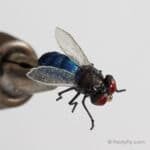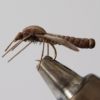Realistic Crane Fly (Daddy Long Legs)
Realistic Crane Fly (Daddy Long Legs) is remarkably close to the real insect in looks, appearance, and the way they move in the water. The superior details mimic the look of the real crane fly so well – they look alive and your fish will not know the difference. Our Realistic Crane Fly has the characteristic long abdomen body, clear wings with truthful details, and the elongated, delicate legs of the real fly. This fly was tied using high quality, floatable, and light material that has just the right weight so when they hit the water, the way they float emulates the real insect accurately. The flexibility and design of the wings and legs add crucial movement to the fly when in water. The realistic look of this fly provides that imperative advantage when fishing this fly pattern. The material is super sturdy – these flies were tied to last and will withstand many takes.
These realistic crane flies are highly effective – expect some explosive strikes!
Comes in 2 colors: Dark and Natural, and hook #12.
Crane Flies Fishing
Order: Diptera (flies), Family: Tipulidae
Crane flies (also known as ‘daddy long legs’ or ‘daddy-long-legs’) resemble large mosquitos but these flies cannot sting and are not very good fliers. This is one of the reasons they are easily blown onto the surface of the water. Their flying sometimes looks wobbly, which is why trout get easily attracted to them. Their life is mostly spent as larvae – they are adults for only 10-15 days. Adult crane flies have long thin abdomen (females have larger abdomen than males), and very long and delicate legs. Their abdomen has a characteristic V-shaped groove. They have large clear wings that span from 1.0 to 7.5 cm (approx. ½ inch to 3 inches). Crane flies are terrestrials, but mostly live around freshwater: rivers, streams, and lakes, in semi-aquatic environments.
Crane flies can be found close to the water surfaces during the early morning, but they are most active around water in the late evening, starting from sundown and sometimes well into the dark. The best conditions to fish them would be breezy weather, as they are easily carried by the wind. However, as they are weak fliers, in these conditions they rarely fly too far from shelter. The ideal would be an evening with intermittent breeze and calm. As for tactics, for fishing crane flies, the dead-drifting technique would be most effective. However, should you see that this is not productive, try skating. As crane flies prefer humid and dump conditions, fall would be a great time to fish these patterns.
Fly Fishing Terrestrial Flies
Terrestrial insects are land-bred. Some of the species of terrestrials include hoppers (grasshoppers), ants, beetles, bees, crickets, etc.
Terrestrials are one of the essential food sources for trout and other game fish during the summer months. Hot summer months are when the aquatic insects become sparse, the trout is the most active and grows the fastest. This is when terrestrials become their most important food source as a rich source of protein. A terrestrial falling into the water is a great and nutritious meal for fish as these insects are usually bulkier and heavier than aquatic insects and they provide a large calorie intake when the trout need it most.
Terrestrial fly patterns are effective from May till October, and sometimes even into November.
As terrestrials are most active and most likely to fall in the river during the day, the best time to fish these fly patterns is anytime from late morning all the way through the evening. Windy days are best as the wind ‘pushes’ them to the water. Optimal locations to present terrestrial patterns are along cut banks, grassy shorelines, or under big trees – places where fish wait for them – easy meals just dropping in. As these insects will eventually be pulled further into the river – midstream can also be a good place to present your fly.
On smaller streams fish are depending mostly on terrestrials as their food source. Small waters don’t have the high-energy riffles where the aquatic insects spend much of their lifecycles. For fishing small streams – terrestrials are a must.
Be it mid-summer, early fall, or the midst of spring – fishing terrestrial fly patterns can provide top dry-fly action!





















Matthew Romalia –
Just got this and trout are smashing it! 100% worth it!